

Originally posted March 24, 2016
Here's an oddity from the early 20th century: a Remington Model 51.
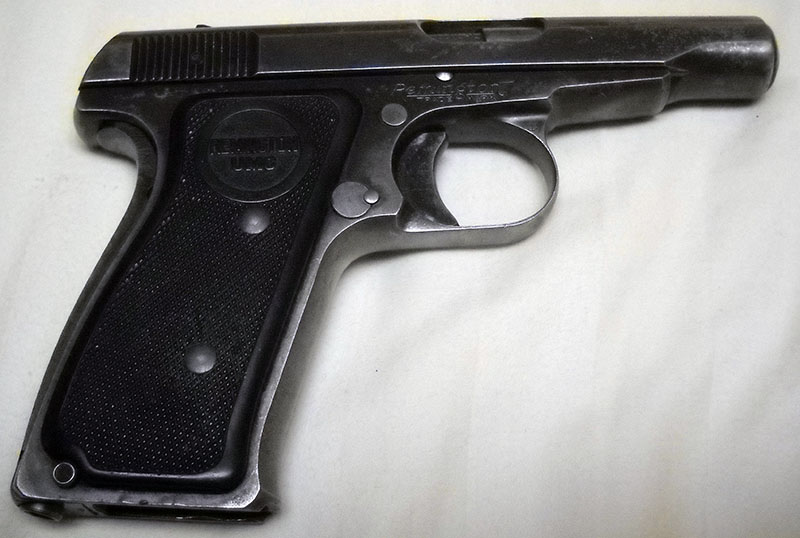
Remington is better known for long guns these days, but they were once a significant presence in the handgun market. Nowadays, when you find a reproduction of a Civil War-era percussion revolver, if it isn't a repro of a Colt, it'll be a Remington. In those days, Remington revolvers were known for their solid frames (as opposed to contemporary Colts, which are open on top), which gave them a certain reputation for ruggedness.
After the percussion era, they seem to have mostly gotten out of the handgun market, but in the early 1900s, they had the services of one of the most talented, least lucky firearms designers of the age, and decided to take the plunge back into handgun manufacturing with one of his designs.
John D. Pedersen (1881-1951) was one of the best-regarded arms designers of his age. No less a personage than John Moses Browning himself called him the greatest in the world; when Major General Julian Hatcher, to whom Browning said this, expressed surprise, Browning explained that he was near the end of his career and expected Pedersen to surpass him in due course. Sadly, that didn't really happen; though Pedersen's designs were interesting and elegant, he had terrible luck with timing, ordnance boards, and the like. To take a couple of examples:
Well... the Remington Model 51 is another one of those, unfortunately. Remington's intention was to compete with the likes of Colt and Savage (the latter of which was at the time a significant player in the automatic pistol market) with a compact, reliable pistol. Pedersen's design, the Model 51, featured a unique "hesitation lock" design that made its action more robust than a simple blowback system, but without infringing on various existing patents (many of them held by Browning) for positive locking systems. It worked by having a fixed barrel, but a breechblock that was separate from the slide. This would recoil a short distance along with the slide (like the barrel and chamber in a conventional short recoil locking system), then be stopped by a mechanical surface inside the slide, until such time as the slide has continued back under its own recoil momentum. That instant's hesitation is enough to allow the bullet to clear the barrel and chamber pressure to drop to safe levels, at which point the breechblock unlocks and the empty case can be ejected.
This system was reputed to make for easier operation and less felt recoil from a given cartridge than the pistol's competitors; since the Model 51 was sold in .380 and .32 ACP, most of these were simple blowback designs, and so relied on slide weight and the stiffness of their recoil springs to operate safely.
In addition, Pedersen paid a lot more attention to ergonomics than most of his competitors. Decades before anyone else was doing it, he made careful scientific studies of grip geometry in the course of developing the Model 51, which made the finished product both more comfortable and more, for lack of a better word, "pointable" than most of its competitors. Remington's advertising material, with hyperbole typical of the era, described the Model 51 as "self-aiming", and though that's an exaggeration, it doesn't feel far wrong.
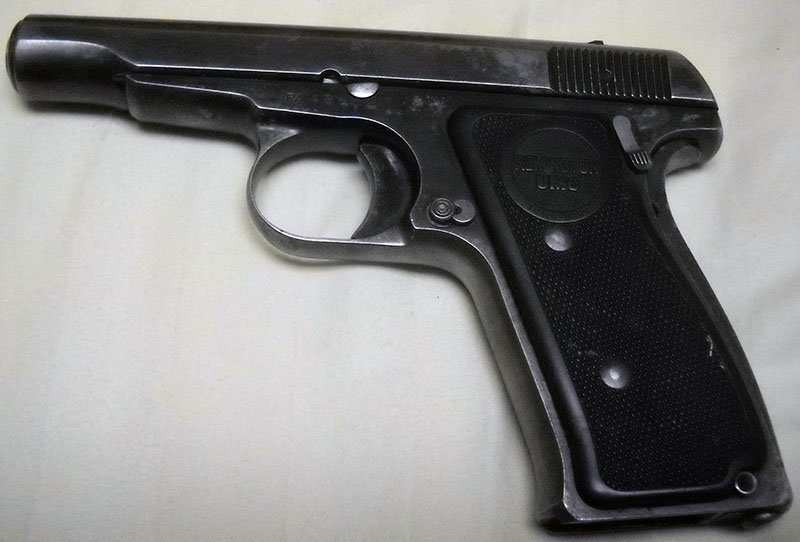
Unfortunately, as was so often the case with Pedersen, his design was perhaps a bit too ambitious and his timing was terrible. The Model 51, with its elaborate locking system and Remington's typical particularity about build quality, cost a lot more than most of its competitors, particularly when the German arms industry began to recover in the 1920s and compact pistols like the aforeseen Ortgies and the Walther PP started appearing on the import market. Couple that with the economic problems of the late 1920s and you begin to see why the Model 51 was only manufactured for nine years, from 1918 to 1927, and Remington had a very hard time getting rid of its back stock after 1929.
There's actually an even sadder, even more typically Pedersonian coda to the Model 51 story. Early in World War I, before the US got involved in the war, Remington pitched a scaled-up .45-caliber version, the Model 53, to the US armed forces as a more reliable replacement for the not-very-long-ago-adopted M1911 (a Colt product designed, naturally, by John Browning). With Pedersen's usual timing, it hadn't been ready for the trials that led to the M1911's adoption, but the Navy, at least, was so impressed by the Model 53 that they did officially adopt it...
... and then the US entered World War I and all the available handgun production in the country was earmarked, by order of the War Department, for the manufacture of M1911s. Remington ended up making those for the Navy instead, and once the war was over, well, they didn't need any more pistols. By the time his .276 cartridge was adopted and then dropped because of Douglas MacArthur's interference a decade later, Pedersen must have pretty much lost the ability to even be surprised by the outcome.
Nowadays, Model 51s are pretty rare, on account of they didn't sell all that well when they were offered, and—weirdly—they are almost never found with their original magazines. Mine doesn't have one at all, which is inconvenient since the Model 51 has a magazine safety. I am therefore not entirely sure it works, but on the other hand, I got a fantastic deal on it (much less than the difference between the usual collector price and the cost of a reproduction magazine, I've just not gotten around to finding one yet). Mine is a .380, which is not my usual cup of tea, but it's not as if one can afford to be that particular when getting a deal on a collector piece as good as the one I got on this. Anyway, I'm a .32 fan but I'm not a snob. :)
The Model 51 has three safety mechanisms (besides the hesitation locking system in its action): the magazine safety, a grip safety (visible at the back of the grip in the photos above), and a thumb safety on the left side that appears to lock the grip safety out (I'm not sure if it does anything else within the lockwork). It has no hold-open, but can be "tricked" into staying open by pulling the slide back and then releasing the grip safety. (This is pretty easy thanks to the gentleness of the recoil spring.)
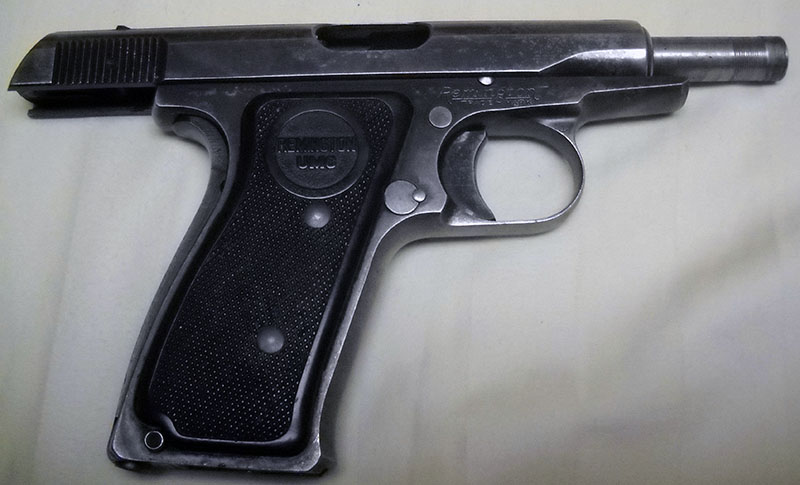
The Model 51 is a nice, compact package, and the grip design does live up to the hype about its comfort (if not quite to the level of being "self-aiming"). Even with the grip safety, which is a thing I generally find annoying, it's a pleasant gun to hold, nicely angled and with no sharp corners. It has the usual tiny '20s pocket pistol sights, to reduce snagging on pockets; then again, it was intended to be used mostly at very short ranges and more by intuition than design, so it was expected by its designer to need them even less than most small handguns of its age.
In a slightly odd design choice, Remington decided to combine markings on the top of the slide with fine serrations intended to reduce glare in the sight picture (even though, as we have already discussed, they didn't think the sights were all that important—go figure). This has the effect of making said markings pretty hard to read.

What that actually says is,
Later-production examples have a different engraving with the numbers of the no-longer-pending patents.
The Model 51 was not a commercial success, but thanks to its innovative design and its superior ergo, it did have its adherents. George Patton had one, personalized like all his pistols; he is pictured with it in several of the better-known photos of him taken during World War II, and seems to have been sufficiently fond of it to have new custom grips made for it whenever he got promoted (it's pictured with grips sporting different numbers of stars depending on what grade of general he was at the time).
There's also an almost comically Pedersonian postscript to the story of the Model 51. Remington got back into handguns a few years ago, bringing out its own retread of the ever-ubiquitous M1911A1. Since that venture did not immediately tank, some bright spark over there hit on the idea of reviving and modernizing the Model 51. This was called the R51 and was announced with great fanfare in 2014. It was first to be offered in 9mm Parabellum, and then later in .40 Smith & Wesson and various other popular handgun cartridges. Almost immediately thereafter, the company announced that it had run into a few production snags with the R51 and suspended production, but assured the buying public at the time, and subsequently at the January 2015 Shooting, Hunting, and Outdoor Trade Show (SHOT, basically the firearms industry's CES or E3), that it would be back Real Soon Now.
At SHOT 2016, there was no sign of it at the Remington booth. Not in person, not in the catalog, not in any of the marketing bumf... nowhere. Erased from history. Never happened. The Valentin Bondarenko of pistols.
Somewhere, the ghost of John Pedersen is just shaking his head.
--G.
Addendum originally posted February 10, 2017
Oh hey, look what's back on Remington's website. Not terrifyingly priced, either. I might have to look into that...
--G.
Addendum 1 originally posted May 2, 2017
I've found out a bit more about the R51's disappearance and reappearance from Remington's product line. Evidently the first-generation ones, um... kind of didn't work, to such an extent that Remington opted to take it away, do a bunch of work on it, and then pretend they hadn't released the first version when they released the second version.
Unfortunately, every indication (and I mean every indication, usually there's some spread to these things, but) I'm seeing is that the second-generation R51 doesn't work either. Even reviewers who desperately want to like it just... can't. The most common factor blamed for this is that Remington decided to position it against the likes of the Glock 43 and Walther CCP in the "compact 9mm Para" category, and at that size, the Pedersen hesitation lock is... not really up to that. (The Model 53, which almost became the U.S. Navy's M1918 sidearm, was bigger and beefier, a full-size service handgun.) I'm sure it also doesn't help that 21st-century Remington's manufacturing QA, at least on the R51 production line, is reportedly appalling.
So, even at the pretty aggressive price point they're currently pushing, I probably won't get one. Not with my own money. I've got way too many other things I could spend it on.
It's such a shame. If they'd just put the Model 51 back into production in .380 and gone after that market segment, they might've had a chance, but no, they decided to modern it up. "Reimagine" it for Today's Tactical Shooter. Alas, that seems to have produced something as faithful to the original as the Tom Cruise Mission: Impossible movie.¹
Anyway, while I'm thinking of my Remington 51, I dug up a very handy 5-part video series on the pistol which (finally) showed me how to get the fershluginer thing apart.
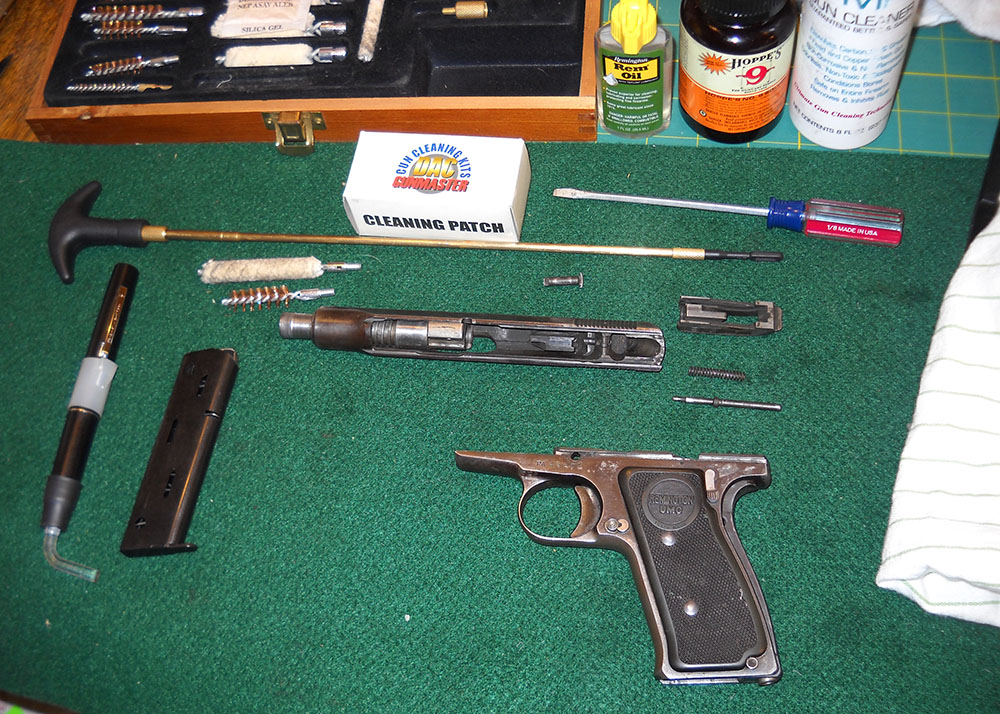
The man who made those videos strongly advised against taking the barrel out, so I haven't, but looking at it, I might have to steel myself and attempt it.
Keep in mind that I've never shot this pistol; I bought it on a "does not work, at your own risk" basis because it didn't have a magazine in it, and is one of those pistols that don't work at all without a magazine, and though I bought an aftermarket magazine for it, I hadn't researched how to get it apart and check to see if everything in there was working.
As such, everything you see in these photos was already like that when I got the gun, which... well, look at it. Whoever shot it last certainly didn't clean it before putting it away, nor did the person who sold it before passing it along. I'm not sure how often it was ever cleaned.
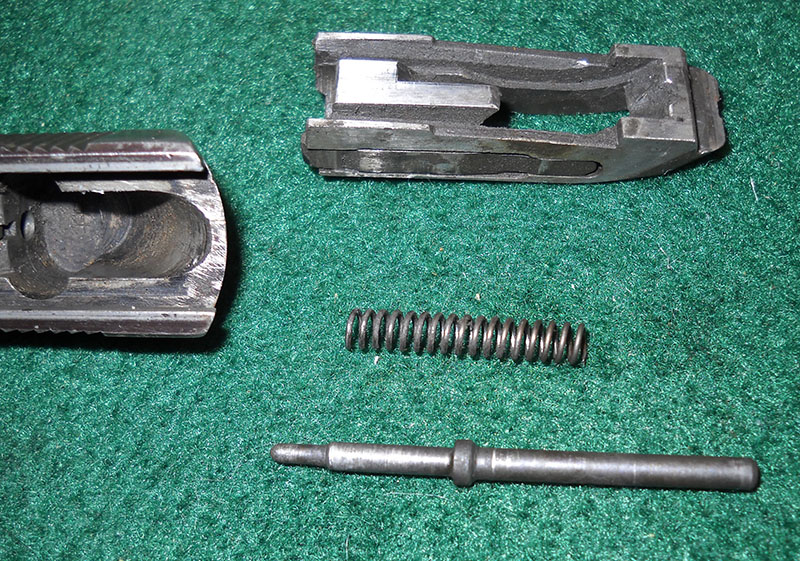
The filth doesn't show up very well in the photos, because under the flash it's more or less the same color that the pieces would be anyway. This is a problem I also ran into with the "before cleaning" photos of the M1 carbine.
Anyway, this picture shows details of the firing pin, its spring, and... well, for brevity's sake we'll call that bit at the top of the photo the bolt, I guess, even though strictly speaking it kind of is and isn't one. It doesn't come out of the gun at any time like a traditional semiauto pistol bolt (compare the Nambu or Ruger), but it does move semi-independently of both the slide and the barrel inside the gun when the action is working. (The videos do a good job of explaining how that works. The Pedersen system is really not much like anything else.)
On the plus side, the bolt looks to be in good condition apart from how dirty it is. The bolt is the weak point of the Pedersen system, as it takes the biggest beating in the course of normal operations (apart from the shoulder in the frame it interacts with, anyway) and they have been known to break. I gather people feeding the pistols hot modern "defensive" .380 ammo is the usual cause for that, and that it's less of a problem with the (rarer, more valuable) .32 version.
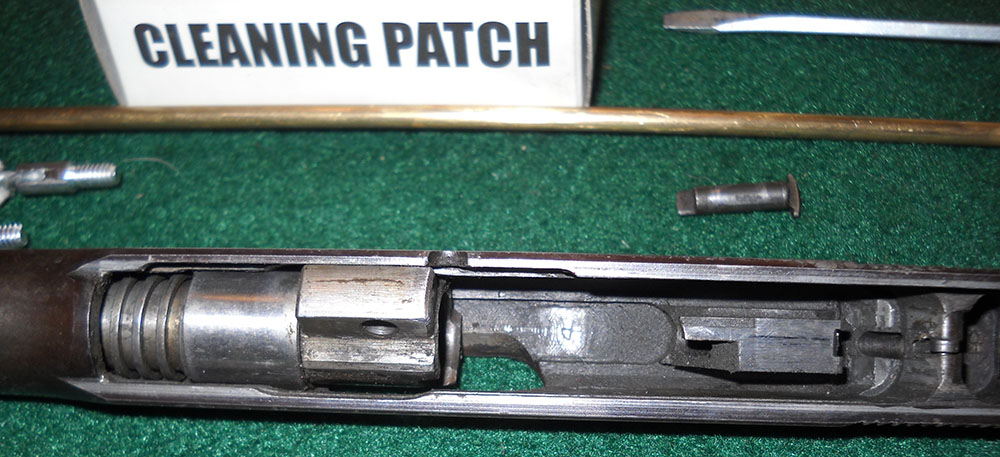
You can see the fouling better in this shot up into the interior of the slide. HINT: That's not supposed to be black in there.
(This is why I say I may need to grit my teeth and try to take the barrel/spring/sleeve assembly apart; the spring is kind of grunged up too, I think less from powder fouling than from just lying around un-oiled for a long time, and I'm not sure how clean I can get it from outside.)
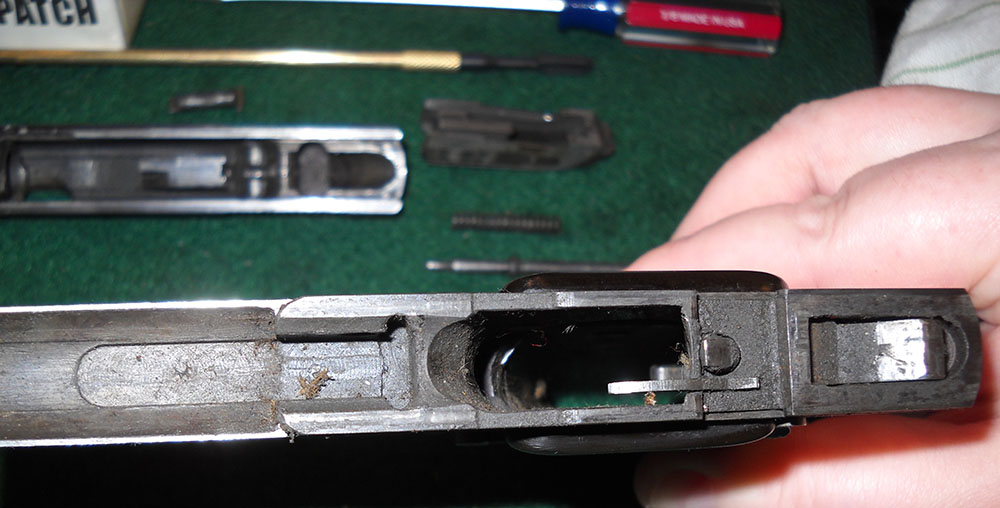
Likewise, the interior of the frame is pretty grungy, not exclusively with burnt powder residue. The whole thing needs a good scrubbing. It's time to go to the drug store and buy a couple of cheap toothbrushes...
(Also in this last photo, you can see that the Model 51 is an internal-hammer-fired design, like the Colt 1903 Hammerless.)
--G.
¹ What? No, screw that, there wasn't more than one.